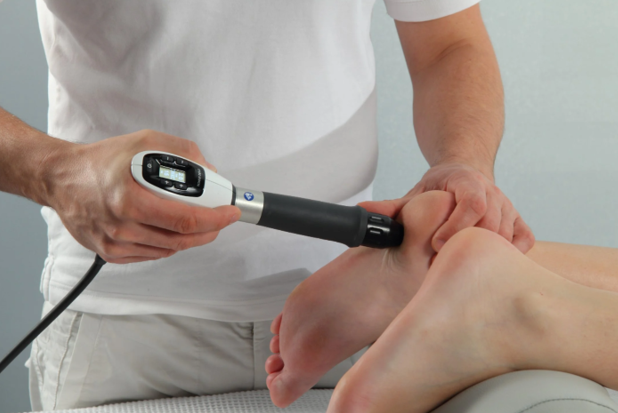Shockwave Therapy
Shockwave Therapy combines radial pressure waves or focused shockwave treatment and vibration therapy. Extracorporeal shock wave therapy ESWT is a non-invasive, effective treatment that can eliminate pain, restore full mobility, and greatly improve quality of life, with beneficial effects typically experienced after only one or two sessions. This Therapy can be used for chronic musculoskeletal disorders and problems, persistent pain, or nagging joint issues, and it is recommended by the National Institute for Health and Clinical Excellence (NICE). Shockwave Therapy can help affected area by increasing healthy blood flow, blood vessel formation, and reducing inflammation, shockwave technology is an effective treatment for an affected area. Shockwave Therapy is clinically proven, recognized by the top orthopedic hospitals, and used by high-profile professional sports bodies. Some people refer to this tool as a stem cell machine because it stimulates your own stem cells to assist in healing and rehabilitation.


What Can Shockwave Therapy Treat?
• Neuropathy
• Knee Pain
• Shoulder Pain and tendinitis of the shoulder
• Hip Pain
• Neck & Back Pain
• Plantar Fasciitis
• Chronic tendinopathy/chronic pain
• Calcifications (calcific tendinitis and rotator cuff calcific)
• Tennis Elbow (elbow tendinopathy and lateral epicondylitis)
• Achilles’ tendinitis
Shockwave therapy is a novel method for treating a variety of musculoskeletal diseases, particularly when other conservative treatments have failed. This type of therapy is regarded as safe, non invasive, low-cost, and free of the risks associated with surgical procedures and postoperative pain.
History of Extracorporeal Shockwave Therapy
In the 1960s and 1970s, scientists began investigating the potential use of shockwaves on human tissue, and by the mid 1980s, shock waves were being used as a lithotripsy treatment to break up kidney stones and gallstones. This marked the beginning of non invasive technologies for treating human tissues.
Extracorporeal Shockwave Therapy (ESWT), also known as shockwave therapy, was first used in clinical practice in 1982 to treat urologic conditions. This technology’s success in the treatment of urinary stones quickly established it as a first-line, noninvasive, and effective method. Following that, ESWT was investigated in orthopedics, where it was discovered that it could loosen the cement in total hip arthroplasty revisions. Furthermore, animal studies conducted in the 1980s revealed that ESWT could improve fracture healing by augmenting the bone-cement interface, increasing osteogenic response, and improving osteogenic response. While shockwave therapy has been shown to aid in fracture healing, most orthopedic research has concentrated on upper and lower extremity tendinopathies, fasciopathies, and soft tissue conditions.
Shock wave therapy has been used to treat certain musculoskeletal disorders for about 15 years. ESWT employs a series of low-energy acoustic waves delivered to the patient’s skin via a transducer and a topical gel as a medium. It is completely non-invasive and does not necessitate the use of anesthesia or pain medications.
Shockwaves work by stimulating tissue repair and reducing pain by activating the body’s innate healing mechanisms. After just one treatment session, many patients report significant pain relief. Patients may experience temporary swelling and tenderness at the treatment site because ESWT causes an inflammatory response, which is the body’s healing mechanism. This is a healthy healing response that should not be suppressed with anti-inflammatory drugs.
Shockwave therapy is particularly effective in the treatment of tendinopathies, which are often slow to heal, as well as tendinosis, a degenerative condition of injured tendons. It is also beneficial in the healing of non-union bone fractures.
Are you a candidate for ESWT?
Regenerative medicine is one of the most difficult and intriguing fields of modern medicine. Extracorporeal shockwave therapy (ESWT) has been shown in basic research to be effective in stimulating biological activities involving intracellular and cell-matrix interactions. These interactions underpin current clinical applications and pave the way for new applications in tissue regeneration.
Reach out to the professionals at Epic Healthcare & Physical Medicine to learn more about physical therapy, the healing process, pain reduction, and the effects of ESWT or to request an appointment at (972) 355-0083.
